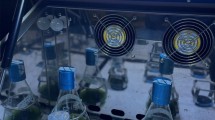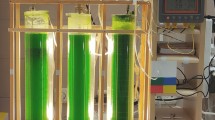Abstract
The development of microalgal biofilms has received very limited study despite its relevance in the design of photobioreactors where film growth may be advantageous for biomass separation or disadvantageous in fouling surfaces. Here, the effects of species selection, species control, and substrate properties on biofilms of Scenedesmus obliquus and Chlorella vulgaris were investigated. Experiments were conducted in batch culture and in continuous culture modes in a flow cell. Cell growth was monitored using confocal laser scanning microscopy and gravimetrically. Species selection and species control had significant effects on biofilm development. On non-sterile wastewater, C. vulgaris shifted from primarily planktonic (23.7% attachment) to primarily sessile (79.8% attachment) growth. The biofilms that developed in non-sterile conditions were thicker (52 ± 19 μm) than those grown in sterile conditions (7 ± 6 μm). By contrast, S. obliquus attained similar thicknesses (54 ± 31 and 53 ± 38 μm) in both sterile and non-sterile conditions. Neither species was able to dominate a non-sterile biofilm. The effect of substrate surface properties was minimal. Both species grew films of similar thickness (∼30 μm for S. obliquus, <10 μm for C. vulgaris) on materials ranging from hydrophilic (glass) to hydrophobic (polytetrafluoroethylene). Surface roughness created by micropatterning the surface with 10 μm grooves did not translate into long-term increases in biofilm thickness. The results indicate that species selection and control are more important than surface properties in the development of microalgal biofilms.












Similar content being viewed by others
References
Adey WH, Loveland K (1991) Dynamic aquaria: building living ecosystems. Academic, San Diego
Augspurger C, Karwautz C, Mußmann M, Daims H, Battin TJ (2010) Drivers of bacterial colonization patterns in stream biofilms. FEMS Microbiol Ecol 72:47–57
Barberousse H, Brayner R, Botelho Do Rego A, Castaing J, Beurdeley-Saudou P, Colombet J (2007) Adhesion of facade coating colonisers, as mediated by physico-chemical properties. Biofouling 23:15–24
Becker K (1996) Exopolysaccharide production and attachment strength of bacteria and diatoms on substrates with different surface tensions. Microb Ecol 32:23–33
Besemer K, Singer G, Limberger R, Chlup AK, Hochedlinger G, Hodl I, Baranyi C, Battin TJ (2007) Biophysical controls on community succession in stream biofilms. Appl Environ Microbiol 73:4966–4974
Borowitzka MA (1999) Commercial production of microalgae: ponds, tanks, tubes and fermenters. J Biotechnol 70:313–321
Brennan L, Owende P (2010) Biofuels from microalgae, a review of technologies for production, processing, and extractions of biofuels and co-products. Renewable Sustainable Energy Rev 14:557–577
Callow ME (2000) Algal biofilms. In: Evans LV (ed) Biofilms: recent advances in their study and control. Harwood Academic, Amsterdam
Chisti Y (2007) Biodiesel from microalgae. Biotechnol Adv 25:294–306
Costerton JW (ed) (2007) The biofilm primer. Springer, New York
Craggs RJ, Adey WH, Jenson KR, St John MS, Green FB, Oswald WJ (1996) Phosphorus removal from wastewater using an algal turf scrubber. Water Sci Technol 33:191–198
Davis L, Hoffmann JP, Cook PW (1990) Seasonal succession of algal periphyton from a wastewater treatment facility. J Phycol 26:611–617
Genzer J, Efimenko K (2006) Recent developments in superhydrophobic surfaces and their relevance to marine fouling: a review. Biofouling 22(5):339–360
Gilbert ES, Keasling JD (2004) Bench scale flow cell for nondestructive imaging of biofilms. In: Spencer JFT, de Spencer AL Ragout (eds) Environmental microbiology: methods and protocols. Humana, Totowa
Gudin C, Therpenier C (1986) Bioconversion of solar energy into organic chemicals by microalgae. Adv Biotechnol Process 6:73–110
Hench LL, Ethridge EC (1982) Biomaterials: an interfacial approach. New York: Academic Press
Heydorn A, Nielsen AT, Hentzer M, Sternberg C, Givskov M, Ersboll BK, Molin S (2000) Quantification of biofilm structures by the novel computer program COMSTAT. Microbiol 146:2395–2407
Johnson MB, Wen Z (2010) Development of an attached microalgal growth system for biofuel production. Appl Microbiol Biotechnol 85:525–534
Kebede-Westhead E, Pizarro C, Mulbry WW (2003) Production and nutrient removal by periphyton grown under different loading rates of anaerobically digested flushed dairy manure. J Phycol 39:1275–1282
Kessler E (1991) Scenedesmus: problems of a highly variable genus of green algae. Bot Acta 104:169–171
Lappin-Scott HM, Costerton JW (eds) (1995) Microbial biofilms. Cambridge University Press, New York
Latour RA (2004) Biomaterials: protein–surface interactions. In: Bowlin GL, Wnek G (eds) Encyclopedia of biomaterials and biomedical engineering. Marcel Dekker, New York
Lawrence JR, Korber DR, Hoyle BD, Costerton JW, Caldwell DE (1991) Optical sectioning of microbial biofilms. J Bacteriol 173:6558–6567
Lawrence JR, Korber DR, Wolfaardt GM, Caldwell DE (1995) Behavioral strategies of surface-colonizing bacteria. Adv Microb Ecol 14:1–75
Morais MG, Costa JAV (2007) Biofixation of carbon dioxide by Spirulina sp. and Scenedesmus obliquus cultivated in a three-stage serial tubular photobioreactor. J Biotechnol 129:439–445
Munoz R, Kollner C, Guieysse B (2009) Biofilm photobioreactors for the treatment of industrial wastewaters. J Hazard Mater 161:29–34
Murray MD (1986) Investigation into the wettability of poly(methylmethacrylate) in vivo. J Dent 14(1):29–33
Nichols HW, Bold HC (1965) Trichosarcina polymorpha gen. et sp. nov. J Phycol 1:34–38
Norman JJ, Desai TA (2006) Methods for the fabrication of nanoscale topography for tissue engineering scaffolds. Ann Biomed Eng 34:89–101
Oswald WJ (2003) My sixty years in applied algology. J Phycol 15:99–106
Pohlon E, Marxsen J, Kusel K (2009) Pioneering bacterial and algal communities and potential extracellular enzyme activities of stream biofilms. FEMS Microbiol Ecol 71:364–373
Pulz O, Gross W (2004) Valuable products from biotechnology of microalgae. Appl Microbiol Biotechnol 65:635–648
Richmond A (ed) (2004) Handbook of microalgal culture. Blackwell, Oxford
Rindi F, Guiry MD (2004) Composition and spatial variability of terrestrial algal assemblages occurring at the bases of urban walls in Europe. Phycologia 43:225–235
Schenk P, Thomas-Hall S, Stephens E, Marx U, Mussgnug J, Posten C, Kruse O, Hankamer B (2008) Second generation biofuels: high-efficiency microalgae for biodiesel production. Bioenergy Res 1(1):20–43
Schumacher G, Sekoulov I (2002) Polishing of secondary effluent by an algal biofilm process. Water Sci Technol 46(8):83–90
Sekar R, Venugopalan VP, Satpathy KK, Nair KVK, Rao VNR (2004a) Laboratory studies on adhesion of microalgae to hard substrates. Hydrobiologia 512:109–116
Sekar R, Venugopalan VP, Nandakumar K, Nair KVK, Rao VNR (2004b) Early stages of biofilm succession in a lentic freshwater environment. Hydrobiologia 512:97–108
Sheehan J, Dunahay T, Benemann J, Roessler P (1998) A look back at the U.S. Department of Energy’s Aquatic Species Program—biodiesel from algae. National Renewable Energy Laboratory—Report NREL/TP-580-24190.
Shi J, Podola B, Melkonian M (2007) Removal of nitrogen and phosphorus from wastewater using microalgae immobilized on twin layers: an experimental study. J Appl Phycol 19:417–423
Stephens E, Ross IL, King Z, Mussgnug JH, Kruse O, Posten C, Borowitzka MA, Hankamer B (2010) An economic and technical evaluation of microalgal biofuels. Nat Biotechnol 28(2):126–128
Tang EPY (1995) The allometry of algal growth rates. J Plankton Res 17:1325–1335
Townsin RL (2003) The ship hull fouling penalty. Biofouling 19(Suppl):9–15
Travieso L, Pellon A, Benitez F, Sanchez E, Borja R, O’Farrill N, Weiland P (2002) BIOALGA reactor: preliminary studies for heavy metals removal. Biochem Eng J 12:87–91
Wolfaardt GM, Lawrence JR, Robarts RD, Caldwell SJ, Caldwell E (1994) Multicellular organization in a degradative biofilm community. Appl Environ Microbiol 60(2):434–446
Yasuda T, Okuno T, Yasuno H (1994) Contact angle of water on polymer substances. Langmuir 10(7):2435–2439
Zippel B, Rijstenbil J, Neu TR (2007) A flow-lane incubator for studying freshwater and marine phototrophic biofilms. J Microbiol Methods 70:335–345
Author information
Authors and Affiliations
Corresponding author
Rights and permissions
About this article
Cite this article
Irving, T.E., Allen, D.G. Species and material considerations in the formation and development of microalgal biofilms. Appl Microbiol Biotechnol 92, 283–294 (2011). https://doi.org/10.1007/s00253-011-3341-0
Received:
Revised:
Accepted:
Published:
Issue Date:
DOI: https://doi.org/10.1007/s00253-011-3341-0




